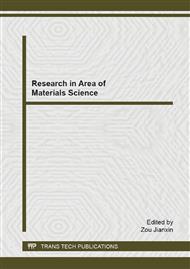[1]
S. Badrinarayanan, N. Zabaras, Sensitivity analysis for the optimal design of metal-forming process, Computer Methods. Applied Mech. Engng., 129 (1996) 319-348.
DOI: 10.1016/0045-7825(95)00859-4
Google Scholar
[2]
L. Fourment, J. L. Chenot, Optimal design for non-steady-state metal forming processes-Ⅰ. shape optimal design method, Int. J. Numer. Methods Engng., 39 (1996) 33-50.
DOI: 10.1002/(sici)1097-0207(19960115)39:1<33::aid-nme844>3.0.co;2-z
Google Scholar
[3]
L. Fourment, J. L. Chenot, Optimal design for non-steady-state metal forming processes-Ⅱ. application of shape optimization in forging, Int. J. Numer. Methods Engng., 39 (1996) 51-65.
DOI: 10.1002/(sici)1097-0207(19960115)39:1<51::aid-nme845>3.0.co;2-#
Google Scholar
[4]
G. Q. Zhao, E. Wright, et. al, Sensitivity analysis based preform die shape design for net-shape forging, Int. J. Numer. Meth Eng., 40 (1997)1213-1230.
DOI: 10.1002/(sici)1097-0207(19970415)40:7<1213::aid-nme110>3.0.co;2-h
Google Scholar
[5]
X.H. Zhao, G.Q. Zhao, G.C. Wang, T.H. Wang, Optimal preform die design through controlling deformation uniformity in metal forging ,J. Mater. Sci. & Technol., 22 (2006)273-278.
DOI: 10.3901/jme.2000.10.064
Google Scholar
[6]
Z.Y. Gao, R.V. Grandhi, Microstructure optimization in design of forging processes , Int. J. Mach. Tools & Manu., 40 (2000)691-711.
DOI: 10.1016/s0890-6955(99)00083-8
Google Scholar
[7]
C. F. Castro, C. A. Antonio and L. C. Sousa, Optimisation of shape and process parameters in metal forging using genetic algorithms, J. Mater. Proc. Technol. 146(2004)356-364.
DOI: 10.1016/j.jmatprotec.2003.11.027
Google Scholar
[8]
I. Doltsinis and T. Rodic, Process design and sensitivity analysis in metal forming, Int. J. Numer. Meth. Eng. , 45(1999)661-692.
DOI: 10.1002/(sici)1097-0207(19990630)45:6<661::aid-nme593>3.0.co;2-v
Google Scholar
[9]
R. P. Luo, H. Yao, Y. H. Peng and Y. Q. Zhang, Preform die shaped design optimization with micro genetic algorithm, Forging & Stamping Technology, 25(2000)52-55.
Google Scholar
[10]
J. Guan, G.C. Wang, T. Guo, et. al, The microstructure optimization of H-shape forgings based on preforming die design , Mater. Sci. and Enging. A, 499(2009)304-308.
DOI: 10.1016/j.msea.2007.11.144
Google Scholar
[11]
Y. H. Yang, D. Liu, Z. Y. He and Z. J. Luo, Method optimization of preform shapes by rsm and fem to improve deformation Homogeneity in Aerospace Forgings, Chinese Journal of Aeronautics, 23(2010)260-267.
DOI: 10.1016/s1000-9361(09)60214-4
Google Scholar
[12]
A. Colorni, M. Dorigo, V. Maniezzo, Distributed optimization by ant colonies. Proc 1st European confartificial life. (1991)134-142.
Google Scholar
[13]
Y. Wen, T. J. Wu, Dynamic window search of ant colony optimization of complex multi-stage decision problems. Proceedings of the 2003 IEEE International Conference on Systems, (2003) 4091-4097.
DOI: 10.1109/icsmc.2003.1245628
Google Scholar


